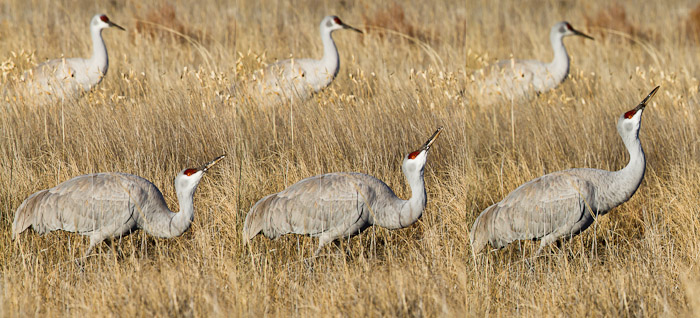Sunday, January 23, 2011 - Bosque Birdwatchers RV Park, San Antonio NM
< previous day | archives | next day >

Glug, Sandhill Crane, Bosque del Apache National Wildlife Refuge, San Antonio NM, January 17, 2011
How cranes drink
When I was rummaging through my files looking for a picture to put up yesterday, I stumbled on a series of pictures of this crane moving in a strange way. Drinking I decided. I guess it wouldn't work to sip through that long beak, hence the dip-and-swoop to let water run downhill.
A quick Google search turned this up:
The muscles that would be needed for sucking are just not present in most birds, probably to minimize weight. Also, birds have a reflex that shuts the glottis (the passageway to the trachea) when they raise the head to swallow food or water. The only birds that do suck are pigeons and doves, one specific finch of northern Australia (the Australian Gouldian Finch), and some oceanic birds called fulmars. Source: Ornithologist Laura Erickson at Learner.org
[Update] I took my regular sundown walk down to the roost at the ponds to watch the watchers watch the cranes come in for the night. Posting this composite picture had me watching the cranes instead; watching for the dip-and-swoop. Yup, it's a regular thing. Photography is giving me a glimpse into the bird world normally too fleeting to grasp. What a hoot! Are the birds we see drinking from birdbaths doing the dip-and-swoop too? Bet they are.
Night camp
Site 10 - Bosque Bird Watcher's RV Park, San Antonio NM
- This is a basic, small Mom & Pop RV Park with full hookups.
- Verizon cell phone and Broadband service are available here with a strong signal.
- Locate Bosque Bird Watcher's RV Park on my Night Camps map
- Click for Google street view
- Check the weather in San Antonio NM
Gets Me Into My Boots
Living in a world where the answers to questions can be so many and so good is what gets me out of bed and into my boots every morning.
A Country Year: Living the Questions by Sue Hubbell